These Tech Notes have been collected from various sources which relate to the proper fabrication and operation of flat conveyor belting, recognizing that following production of the belt, independent fabricators/distributors must customize the product for customer use in a variety of applications and utilize a variety of operating equipment. These notes are intended to only be used as a guide. Please refer to the NIBA legal disclaimer at the bottom of this page for more details.
Belt Camber
If unbalanced warp tensions exist in a conveyor belt, that belt will usually assume a crescent or banana shape when laid flat upon a horizontal surface. This deviation from a straight line is hereby defined as camber.
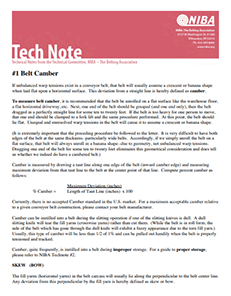 Download as PDF
Download as PDF(PDF – 69.37 KB)
Belt Storage and Shipping
Modern conveyor belts are very durable products, but they can be adversely affected by improper storage and shipping practices. The basic recommended practices for belt storage/shipping are as follows:
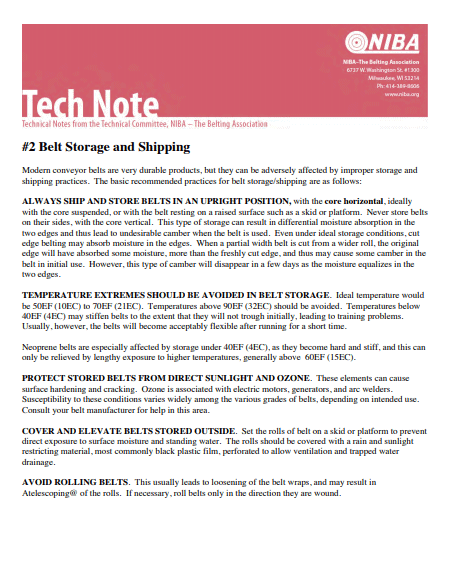 Download as PDF
Download as PDF(PDF – 63.02 KB)
Conveyor Belt Tracking Guide
BASIC RULES I. The basic, and primary rule of tracking a conveyor belt is simply “THE BELT MOVES TOWARD THAT END OF THE ROLL IT CONTACTS FIRST.” II. The conveyor structure must be “TRUE” (relative to center-line) and LEVEL (side to side).
(PDF – 67.47 KB)
Dust Suppression Systems
The necessity to control dust in industry and mining has spawned a number of dust suppression systems. Many such systems exist today. It is likely that these systems will find ever wider acceptance in the marketplace.
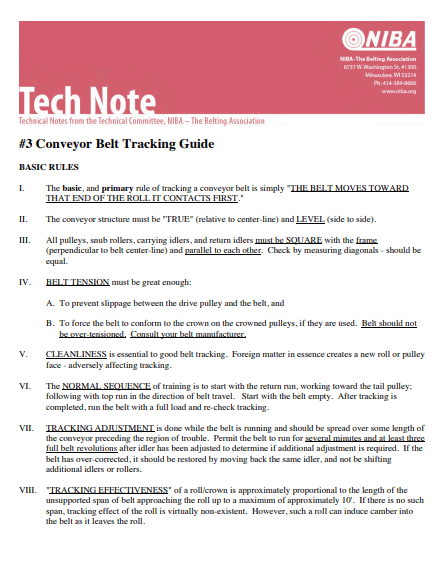 Download as PDF
Download as PDF(PDF – 57.26 KB)
Fire Resistant or Flame Retardant
Safety requirements in conveyor/elevator belting applications where fire and/or explosion are a consideration frequently involve:
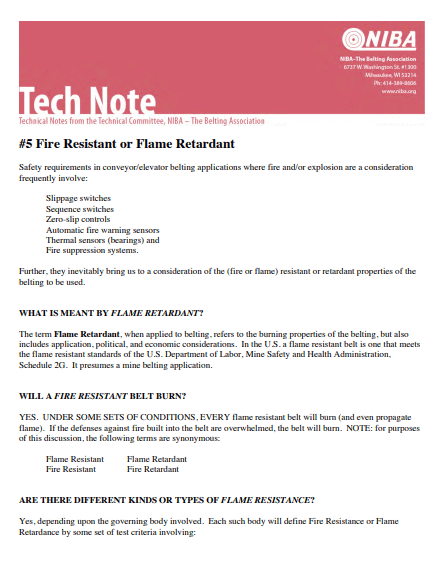 Download as PDF
Download as PDF(PDF – 83.44 KB)
OSHA/Grain Belt
GRAIN HANDLING FACILITIES: FINAL RULE Everyone involved in the handling of grain and/or feed should be aware of the new OSHA regulations as detailed in The Federal Register of December 31, 1987. You may obtain a copy of the OSHA regulations from your industry associations or from The Government Printing Office.
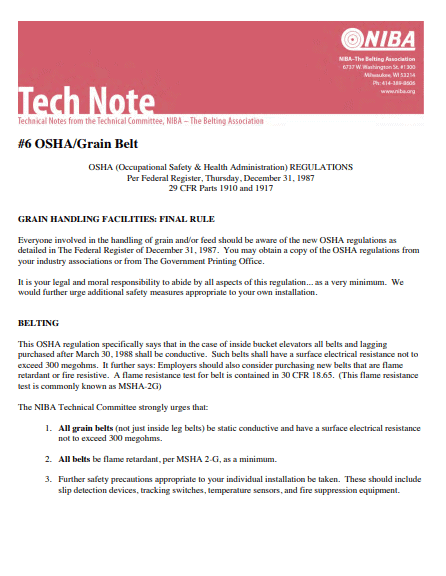 Download as PDF
Download as PDF(PDF – 61.94 KB)
Minimum Belt Tension
WHAT IS PROPER MINIMUM BELT TENSION? Proper minimum belt tension is the tension required so that a given belt conveyor or belt elevator system will operate properly in its environment.
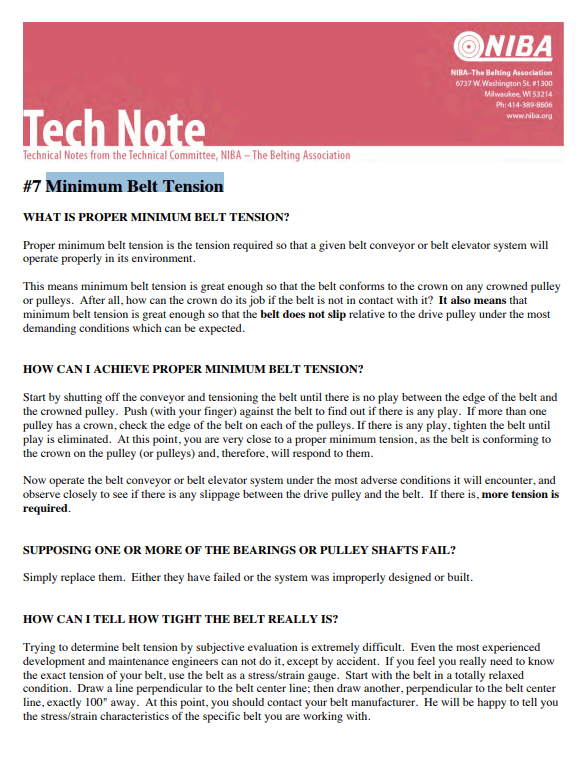 Download as PDF
Download as PDF(PDF – 81.05 KB)
Compound Comparison Guide Conveyor Belting
Compound Cross Reference By Manufacturer (Heavy Duty Belting)
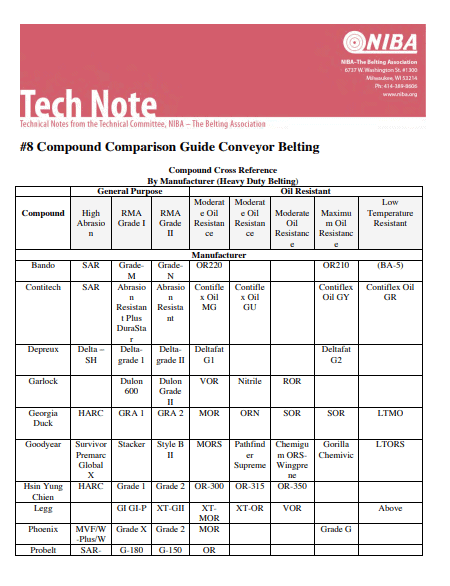 Download as PDF
Download as PDF(PDF – 90.40 KB)
Static Electricity Considerations
NATURE OF STATIC ELECTRICITY Static electricity is defined as electrical charge at rest. It can be generated by the triboelectric effect and can be accumulated by conductive and inductive charging.
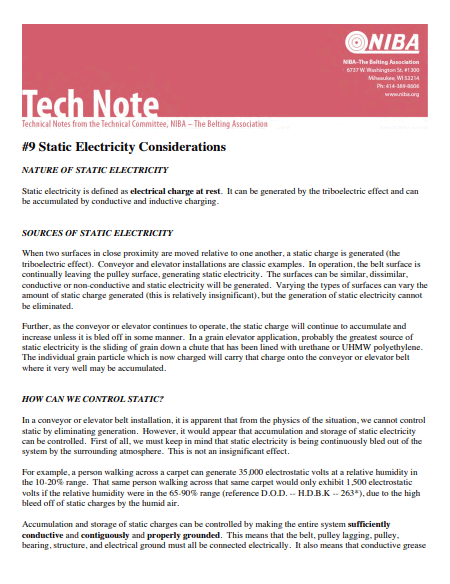 Download as PDF
Download as PDF(PDF – 77.96 KB)
Impact Resistance of Belting
Many different methods exist to measure the impact resistance of belting. However, there is no standard test method for measuring impact… consequently, there are no minimum standards.
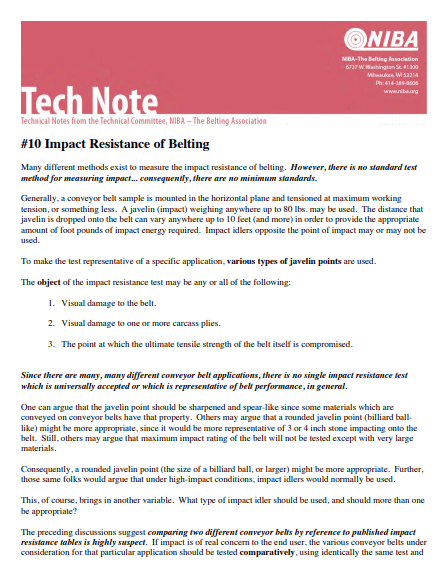 Download as PDF
Download as PDF(PDF – 81.38 KB)
Conveyor Belt Polymers
A wide variety of polymers are used in conveyor belts, providing the various properties that the many types of applications require. All of the polymers have basic properties that are well known and well documented. However, the polymers are never used in their pure form in conveyor belts. Rather, they are used in compounds, which mixes them with other materials so that the end products have enhanced properties.
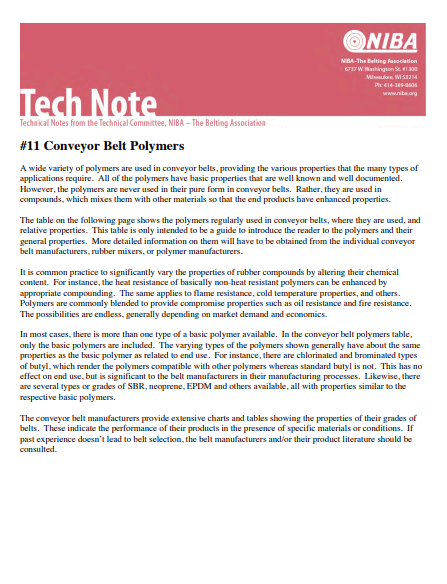 Download as PDF
Download as PDF(PDF – 59.08 KB)
Conveyor Belt Repair Options
It is generally recognized in bulk materials conveying that optimum belt life has been achieved when belt cover and carcass wear out at about the same time. If a belt must be removed from service because of carcass breakdown or injury and much cover thickness is still in place, some of the cover life is wasted.
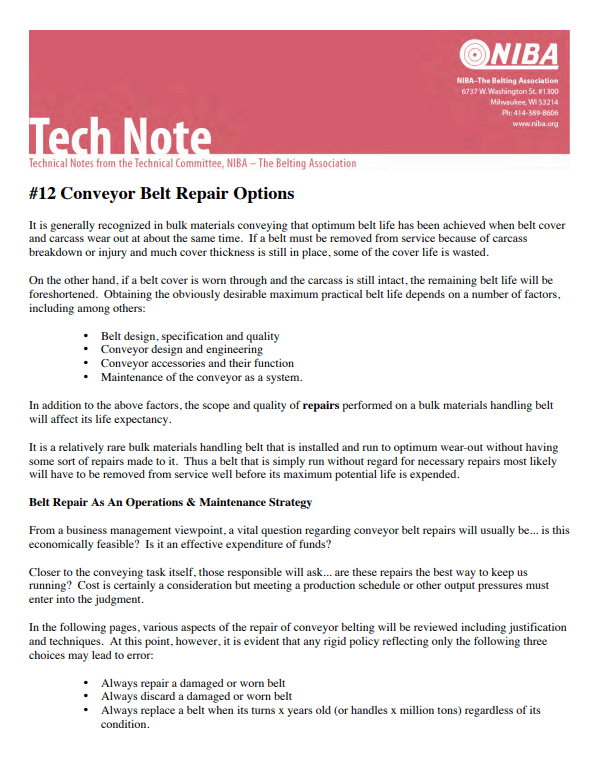 Download as PDF
Download as PDF(PDF – 98.28 KB)
Buffing/Cleaning
During the course of preparing conveyor belting to be spliced or repaired, it will become necessary to perform buffing and cleaning operations. This is intended to serve as a general guideline when performing those operations.
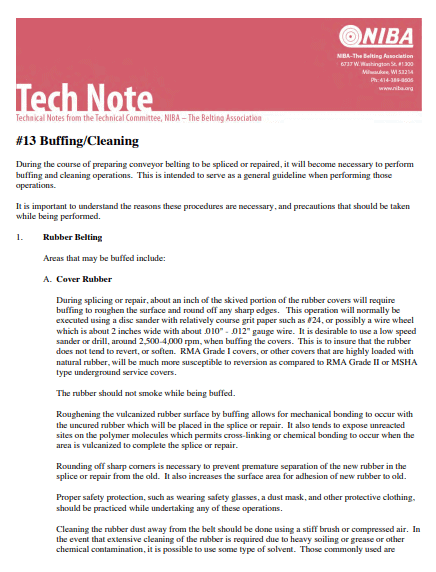 Download as PDF
Download as PDF(PDF – 65.56 KB)
Establishing Centerlines and Squaring Belt Ends for Splicing
Crooked flat belt splices cause a number of operational problems that probably could be avoided if accurate centerlines or square lines had been established when the splices were made. All flat belt splicing requires careful establishment of reference or cut lines that ensure that the belt alignment will be straight through the splices. In vulcanized splices, this applies to a number of lines on both belt ends, all of which are referenced to a centerline or transverse line that is truly accurate. In mechanical fastener splices, this applies to the transverse cut line on the two ends to be joined. There are some mechanical fastener splices that are made at an angle, and these also require establishment of an accurate transverse line.
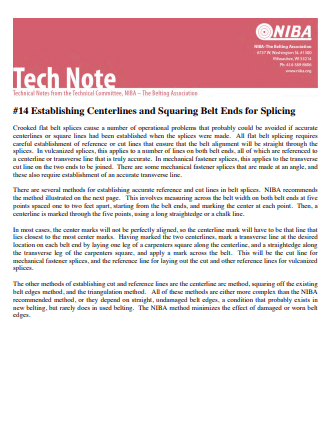 Download as PDF
Download as PDF(PDF – 55.40 KB)
Splicing Tools for Hot/Cold Splice, Fabric Ply Belt or Steel Cable Belt
The procedure in splicing conveyor belts will vary slightly among manufacturers, but the steps and tools will remain relatively constant. The main difference is between fabric plied belt, versus steel cable belting.
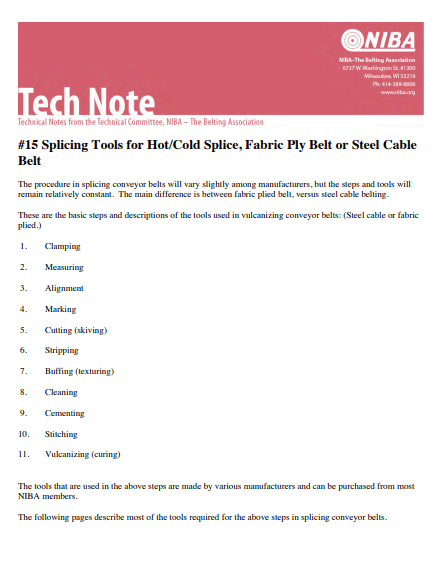 Download as PDF
Download as PDF(PDF – 73.10 KB)
Conveyor Belt Modulus of Elasticity
Belt modulus is a measure of a belt’s resistance to stretching. Frequently, the degree to which a belt stretches in a given application is a problem source. Understanding the belt modulus values and their use can help us recommend the proper belt. This understanding can also help provide a solution in a problem situation. It is useful to remember that the higher the belt modulus value, the lower the belt elongation or stretch will be at any given tension.
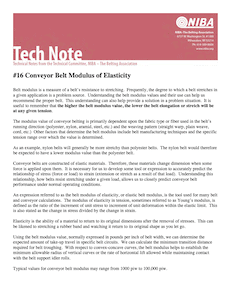 Download as PDF
Download as PDF(PDF – 76.12 KB)
Purposes of V-Guide Notching
V-guides are often applied to the back surfaces of conveyor belting. This is usually done to assist the belt’s ability to track on conveyor systems. Many times these guides are selected for wide width, short center conveyors that are notorious for having belt training problems. Design engineers often specify v-guides be used when take up mechanisms are not easily manipulated to center moving belts on head or tail pulleys.
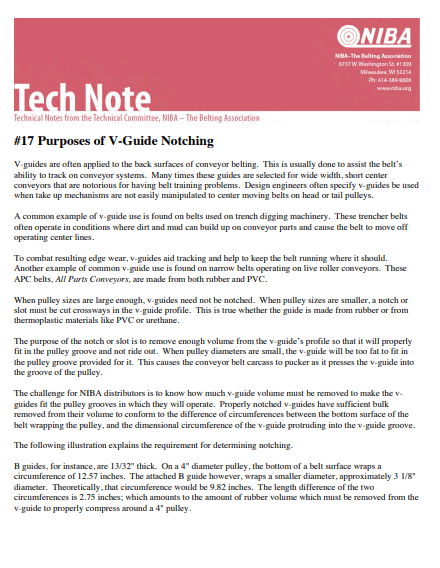 Download as PDF
Download as PDF(PDF – 67.33 KB)
Arrangement of Edges when Belts to be Spliced Together are Cut from Wider Slabs
Belts that are slit from wider manufactured slabs may exhibit a systematic tracking characteristic of running to one side of the conveyor. Such condition is usually easily accommodated by normal training procedures. However, when two or more lengths of belts slit from wider slabs are spliced together to form longer belts, this systematic tracking phenomena may present a problem: the lengths of belts may track off to alternate sides, making training for a single condition impossible, and perhaps preventing effective training of the resulting belt.
 Download as PDF
Download as PDF(PDF – 67.34 KB)
Metric Specifications for Conveyor Beltings
Although the English system of measurement is still prevalent in the United States, metrification has been adopted in virtually all other industrial nations.
 Download as PDF
Download as PDF(PDF – 65.63 KB)
Troubleshooting Belting and Conveyor Component Problems Related to Material Buildup
The following is a quick guide to common problems along with solutions for reducing material buildup on belting and conveyor systems.
 Download as PDF
Download as PDF(PDF – 104.71 KB)
PIW, EP, ST: What’s the Difference
You are busy at your desk when the call comes in asking for your equivalent of a 4 ply EP 3800 conveyor belt. Your response is of course “NO PROBLEM, I’LL MAKE A QUICK CONVERSION AND GET RIGHT BACK TO YOU.” After hanging up you realize the problem is deeper than it first appeared. Should your answer be given in PIW, EP, or ST rating? Does the Safety factor need to be taken into consideration? Questions, questions, questions!
 Download as PDF
Download as PDF(PDF – 161.45 KB)
Curve or Turn Belts
A growing number of applications require the use of curve or turn belts. Due to the nature of the application, considerable precision is needed in order to achieve accurate dimensions of the belt. In addition, the strength (warp) in the conveyor belt must always be in the running direction.
 Download as PDF
Download as PDF(PDF – 64.93 KB)
Abrasion Resistance of Conveyor Belts
Abrasion resistance of conveyor belt covers is one of the most important properties of a belt. As conveyor systems have improved in quality in recent years because of better maintenance, alignment, and rip detection systems, premature or catastrophic failure has been reduced and gradual wear of the belt covers become a more common form of belt change out.
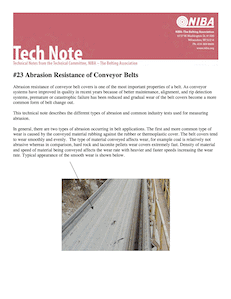 Download as PDF
Download as PDF(PDF – 433.12 KB)
Standards and Standards Organizations
What are standards? Standards are documented agreements containing technical specifications or other precise criteria to be used consistently as rules, guidelines, or definitions of characteristics, to ensure that materials, products, processes and services are fit for their purpose. Therefore, International standards contribute to the reliability and effectiveness of the goods and services we use.
 Download as PDF
Download as PDF(PDF – 94.08 KB)
The Basics of Lightweight Conveyor Belting
The overall belting market share for lightweight conveyor belting has increased modestly over the past couple of decades. The primary reasons for the increase are process automation, market globalization, and competition. Process automation has resulted in increased demands on belting that often require the properties of a lightweight belt design. Globalization and competition have influenced equipment manufacturers to keep up with the latest in lightweight, low cost and energy efficient designs. The move toward faster process and transport speeds, combined with compliance to increasingly strict standards in areas such as noise and sanitation, has favored the growth of lightweight belting.
 Download as PDF
Download as PDF(PDF – 114.72 KB)
Introduction to Plastic Modular Belts
Since their introduction more than thirty years ago, the popularity of plastic modular belts has grown steadily. Constructed of injection-molded modules and hinge rods, plastic modular belts are positively driven and tracked by plastic sprockets. This positive drive and tracking system eliminates slippage, preventing damage to the belt’s edge and the potential for product contamination or premature belt failure.
 Download as PDF
Download as PDF(PDF – 151.86 KB)
Flat Power Transmission Belting
Transmit Power One of the basic tasks for transmission belting is for transmitting power from a source to a driven pulley. This is done through friction between the pulley and the belt, which is transferred through the belt’s core or strength member by way of surface contact and tension.
 Download as PDF
Download as PDF(PDF – 104.90 KB)
